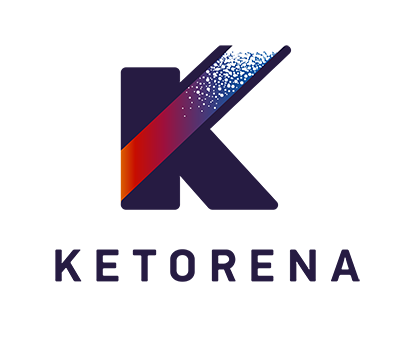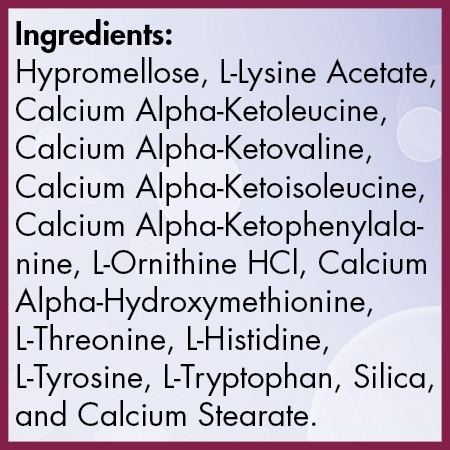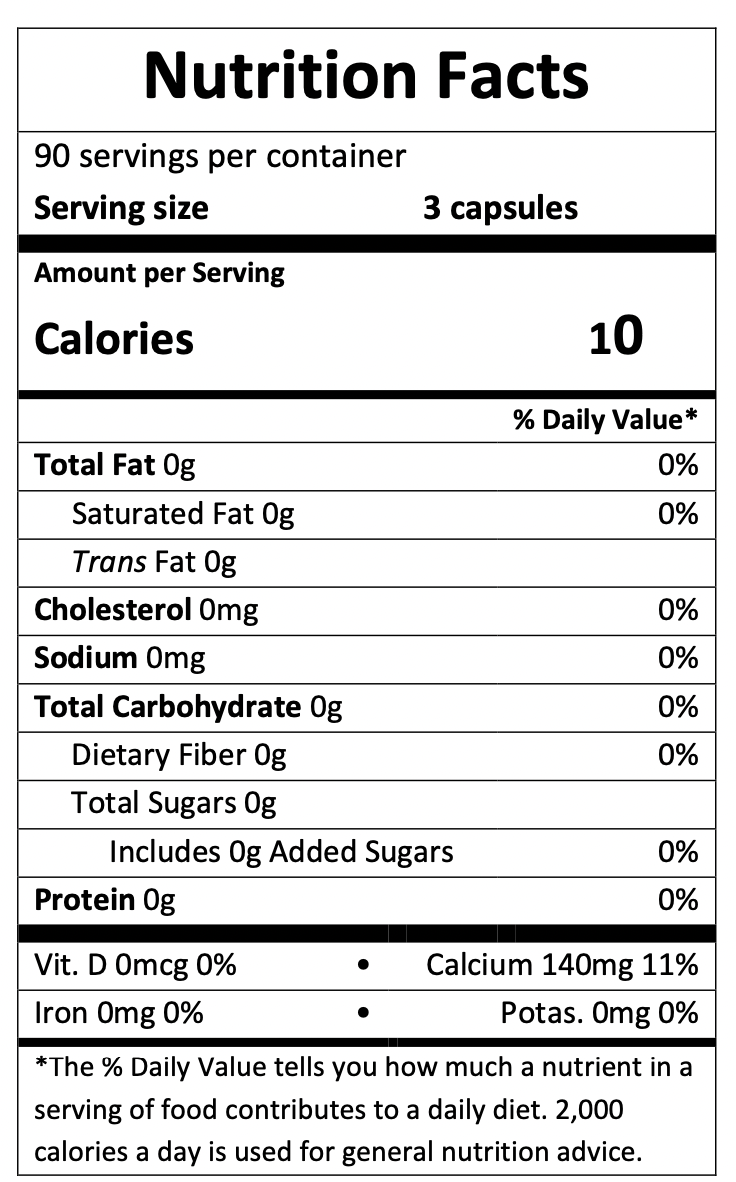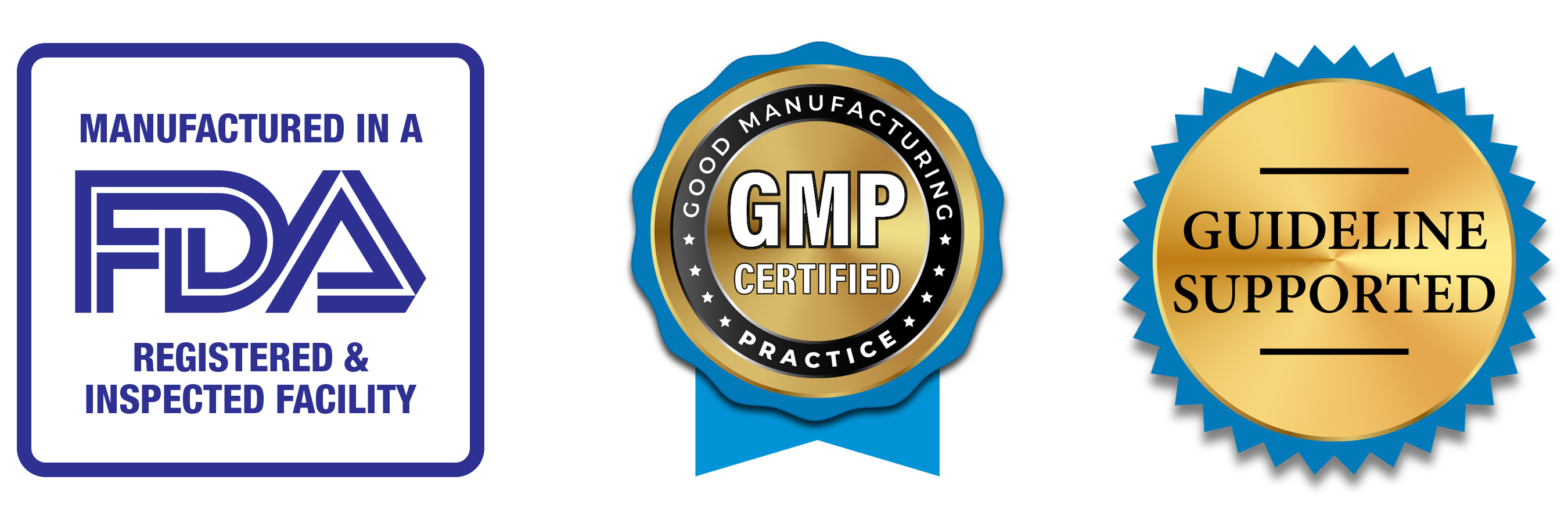CKD Patient Information
Click here to watch a short video on how a low protein diet with Ketorena may help improve kidney disease and slow kidney function decline.
Partner with a Professional Dietitian.
Low protein diet resources for Patients and Caregivers

- 2.1g of Keto & Amino Acids per dose (3 capsules).
- 5.1g of protein per dose with proper diet (3 capsules).
- Developed by a Board Certified Nephrologist in the USA.
- Contains no magnesium.
- Made in the USA in an FDA inspected facility.
- Use under the care of a qualified Health Care Practitioner.
Low Protein Diet in CKD
Low protein and very low protein diets have been clinically proven to slow the progression of CKD and help retain kidney function, and delay the need for dialysis. This has also been shown even when kidney disease is in an advanced stage.
Clinical trials in people with very advanced CKD who wish to initiate a very low protein diet plus a keto-analogue may be able to add years to the functionality of their kidneys. More importantly, when the clinical trials have compared the rate of death and hospitalization in patients who initiated a very low protein diet supplemented with a keto-analogue, versus similar people who started dialysis, the people who initiated the very low protein diet plus a keto-analogue lived longer and were hospitalized less than the people who started dialysis.
When protein is metabolized, part of the metabolism process creates waste products that can increase the level of nitrogen and acid in your body. The kidneys have to work harder to remove these waste products. This extra work can accelerate CKD and the rate of kidney function decline.
One concern with low and very low protein diets is that they can lead to malnutrition and reduced muscle strength because of the reduction in protein intake. Your Health Care Provider may call this type of malnutrition Protein Energy Wasting.
In order to reduce the possibility of Protein Energy Wasting from happening, a scientifically formulated blend of essential amino acids with keto forms and non keto forms of essential amino acids have been used with good success. Ketorena is a keto-analog of keto form and non keto form essential amino acids. All keto-analogs are a blend of Keto form amino acids and non keto form amino acids as only 5 of the essential amino acids found in keto-analogs are available in keto form. Keto-analogues are designed to provide the needed essential amino acids for proper nutrition with lower amounts of metabolites found in protein (especially animal protein) that can be harmful to the kidney.
The nutritional strategy of pairing a low or very low protein diet supplemented with a keto-analogue is designed to provide the needed nutrition for healthy living with less kidney damaging metabolites.
Clinical guidelines and consensus statements by leading kidney doctors recommend a low or very low protein diet treatment strategy for reducing the progression of kidney disease and as a means to avoid or delay dialysis. A low or very low protein diet may need to be supplemented with a keto-analogue. You doctor and dietitian will work with you to determine if supplementing with a Keto-analog is necessary.
Keto-analogues have not been widely available in the USA until now.
Partnering with a professional dietitian is likely the most important factor in altering the course of your CKD, getting the nutrition you need, while improving your energy and quality of life.
Below are two videos introducing Jessiana Saville from the Kidney Nutrition Institute and Jennifer Moore from Plant Fed Wellness.
What is a clinical practice guideline?
A clinical practice guideline is a clinically proven method to treat a patient for a specific ailment. The group that produces guidelines for kidney doctors is the National Kidney Foundation. The guidelines are called the KDOQI guidelines. In 2020 they updated the clinical guideline for nutrition in CKD.
Your doctor may not be aware of this newly updated guideline.
The 2020 KDOQI Clinical Practice Guideline For Nutrition in CKD. Guideline 3 Protein and Energy Intake.
Protein Restriction, CKD patients not on dialysis and without diabetes
In adults with CKD 3-5 who are metabolically stable, we recommend under close clinical supervision, protein restriction with or without keto acid analogues, to reduce the risk of end stage kidney disease (ESKD)/death (1A) and improve quality of life (QoL)
A low protein diet providing 0.55-0.60g dietary protein/Kg body weight/day or
A very low protein diet providing 0.28-0.43g dietary protein/Kg/body weight/day with additional keto acid/amino acid analogues to meet protein requirements )0.55-0.60 g/Kg/body weight/day.
Low protein diet or very low protein diet supplemented with a keto-analogue
Low protein diet (LPD) or very low protein diet + keto-analogue (VLPD + KA) are both considerations
Protein restriction plus KA supplementation (page S45): For adults with CKD without diabetes, not receiving dialysis, with an eGFR <20 ml/min/1.73m2, a VLPD providing 0.28-0.43 g protein/Kg BW day with the addition of KAs to meet protein requirements may be recommended.
A VLPD supplemented with KAs could help preserve kidney function in patients with CKD 3-5 (Page S46)
Considerations of metabolically stable
In the context of these recommendations, metabolically stable indicates:
The absence of any active inflammatory or infectious disease.
No hospitalization within 2 weeks.
Absence of poorly controlled diabetes and consumptive disease such as cancer.
Find the full guideline here: KDIGO 2020 Nutrition in CKD guideline
About Ketorena
Ketorena is a keto-analogue of essential amino acids developed by a board certified, USA trained Nephrologist. Ketorena taken in combination with a low or very low protein diet, is designed to slow the progression of Chronic Kidney Disease (CKD), avoid or delay the need for dialysis and improve nutrition for physical health and well being.
The essential amino acids in Ketorena are designed to provide needed nutrition for health and well being with reduced production of nitrogenous waste products found in protein that can be harmful to the kidney.
Ketorena is designed for safety with low calcium content and no magnesium, which has risk of accumulating in people with CKD if taken in high doses.
Each dose of Ketorena contains 2.1g of Keto & Amino Acids. Each 2.1g dose when taken with a proper protein restricted diet offers 5.1g protein.
Ketorena has no relation to ketogenic diets. Ketorena is a keto-analogue of essential amino acids specifically designed to be used with a low or very low protein kidney diet. Ketorena in combination with a low protein diet, is designed to slow the progression of CKD with the goal of avoiding dialysis, extending lifespan and improving the quality of life.
Ketorena is not a Low Nitrogen Protein Food. Ketorena is a keto-analogue of essential amino acids. The use of a low protein diet supplemented with a keto-analogue of essential amino acids is a clinically proven and guideline supported method to slow the progression of Chronic Kidney Disease.
Your Doctor, a low protein diet and Ketorena
We are often asked, by people with CKD why their doctor hasn't suggested the use of a low protein diet supplemented with Ketorena.
Their may be several reasons why, but often the reason is that Keto-Analogues like Ketorena have not been available in the USA until recently and the guidelines supporting protein restriction are new.
Because Keto-Analogues like Ketorena have not been available in the USA, many medical schools have not trained their Doctors on how to use a low protein diet in combination with a Keto-Analogue as a treatment option to treat CKD, slow CKD progression and avoid or delay dialysis.
The clinical trials on the use of Keto-Analogues are often conducted in Europe and Asia where the use of a low protein diet supplemented with a Keto-Analogue like Ketorena is much more common.
In many cases you may have to let your doctor know that you are interested in keeping your kidney function as strong as possible, and that you want to initiate a low protein diet with Ketorena.
Ketorena Dosing
The guideline states that there are two options to restricting protein to slow CKD as you can read above.
The details of the guideline state that many people with CKD can live a healthy life while restricting protein to 0.55-0.60g of protein per kilo of body weight per day. This is considered a low protein diet or LPD.
The guideline also states that to further reduce the decline in kidney function beyond the benefit of an LPD, a very low protein diet or VLPD of 0.28-0.43g of protein per kilo of body weight per day plus the addition of a keto-analogue is an option.
To understand dosing let's start with an example:
Julia weighs 130lbs. 130/2.2 = 59 Kg.
59 x 0.55 or 0.60 is about 32.5 or 35.5. So if Julia wants to protect her kidneys from further decline she should eat between 32.5g and 35.5g of protein per day.
Let's say Julia is interested in slowing her CKD as much as she can so she wants to try a very low protein diet + Ketorena.
59 x 0.28 or 0.43 is about 16.5 or 25.5. With the VLPD Julia is protein deficient and needs to make it up with the low nitrogen low acid load Ketorena Keto-analogue.
Ketorena is used to bridge the protein gap between the very low protein diet and the low protein diet while keeping the nitrogen and acid loads as low as possible.
Each dose of Ketorena has 2.1g of Keto-analogue per dose which in combination with a proper VLPD offers 5.1g of protein. There is a very important distinction that has to be made: both LPDs and VLPDs have to be done properly. This is why we have a list lower down on this page of consultant renal dietitians who can help with a proper LDP or VLPD. Please remember Ketorena is a medical food an needs to managed under the care of a qualified health care provider.
Let's go back to Julia. So Julia decides to use the VLPD and she eats 0.30g of protein per kg of body weight per day so she eats 17.7g. (59 x 0.30) . But the guideline indicates she needs 32.5g - 35.5g of protein per day. The gap filler is Ketorena. each dose offers 5.1g. So 5.1 x 3 doses per day = 15.3g. 17.7g from Julia's VLPD + 15.3g from Ketorena = 33g protein per day.
People who may benefit from a low or very low protein diet supplemented with Ketorena:
- Those with advanced disease who wish to find an alternative to dialysis.
- Those with CKD stages 4-5.
- Those with CKD stage 3 with a progressive decline in GFR.
- Those with nephrotic syndrome who are being considered for a low protein diet.
- Those who are post transplant with CKD 3-5 or those with proteinuria.
- People on dialysis (PD or incremental HD) with residual renal function.
Initiating a low protein diet supplemented with Ketorena: The team approach
Ketorena is a medical food and should be used under the care of a qualified Health Care Practitioner. Working with both your kidney Doctor as well as a Renal Dietitian may be the best way to achieve success initiating and maintaining a low protein diet to slow the progression of CKD.
Renal Dietitians are professionally trained dietitians who specialize in the nutritional needs of people with kidney disease.
Your Kidney Doctor will monitor your lab values and overall progress while collaborating with your Renal Dietitian to make any needed alterations in diet, meal planning or Ketorena dose.
If your doctor doesn't have a consulting renal dietitian, the following dietary professionals and organizations offer low protein dietary consultation and guidance:
- Jessianna Saville, MS, RDN, Renal Dietitian and Dietary Consultant. You can reach Jessiana and her team of consultant Renal Dietitians at www.kidneyrd.com.
- Kay Head, RD, LD Renal Dietitian and Dietary Consultant. You can reach Kay at kidneyrd.com/kay-head
- Jennifer Moore, MS, RDN, Renal Dietitian and the Author of 'Plant-Fed Kidneys'. You can reach Jennifer at [email protected]m
- Kristi Edwards, MS, RDN, Renal Dietitian and Co-founder of 901 Nutrition. You can reach Kristi at [email protected]
- Nicole DeMasi Malcher, MS, RD, CDE, Renal Dietitian and founder of DeMasi Nutrition. NIchole accepts Medicare and can be reached at NicoleDeMasi.com
- Aisling Whelan MS, RDN, CDN. Founder of the Kidney Nutrition Clinic. Aisling accepts Medicare. Learn more at www.kidneynutritionclinic.com
Converting to Ketorena from tableted keto-analogues.
3 capsules of Ketorena contain 2100 mg or 2.1g of keto/amino acids. Most, but not all tableted keto-analogues contain 600mg of keto/amino acids per tablet.
Ketorena can be taken 2-3 times per day depending on the converted dose.
A typical dose conversion may look like: 600mg tablets x 10 per day = 6000mg or 6g total daily dose
3 capsules of Ketorena: 2100 mg or 2.1g x 3 = 6300mg or 6.3g total daily dose.
Ketorena capsule ingredients:



Frequently Asked Questions
A: Currently Ketorena is available to purchase directly from us on this site or by calling 1-844-980-9933. A 90 serving canister of Ketorena costs $159.50. We offer a $17.50 discount and free shipping for purchases of 2 or more canisters, which brings the price down to $142.00 per canister. While this is expensive, other foreign sourced keto-analogues cost between $250-$450 per month.
Medical Foods like Ketorena, when recommended by a Health Care Provider, are often a qualified tax deductible medical expense.
Medical Foods like Ketorena may also be purchased under a Health Saving Account (HSA). More information can be found by
Clicking HERE to read the IRS guidance on this.
A: The definition of low and very low protein diets for those with CKD vary, but generally most health care providers consider a low protein diet to consist of 0.6g protein/Kg of body weight/day. A very low protein diet typically consists of 0.3g protein/Kg of body weight/day. The US RDA recommends 0.8g protein/Kg body weight/day for those without CKD. The typical American diet is high in protein and consists of 1.0g or more of protein/Kg body weight/day.
For someone weighing 150 lbs (68 kg), the daily protein intake for a low protein diet would be 0.6g x 68 = 40.8g
For someone weighing 150lbs (68 kg), the daily protein intake for a very low protein diet would be 0.3g x 68 = 20.4g
A: Unlike supplements, Medical Foods are regulated under the FDA Orphan Drug Act. They are for the management of specific diseases and are used and dosed under the supervision of a health care provider.
|




